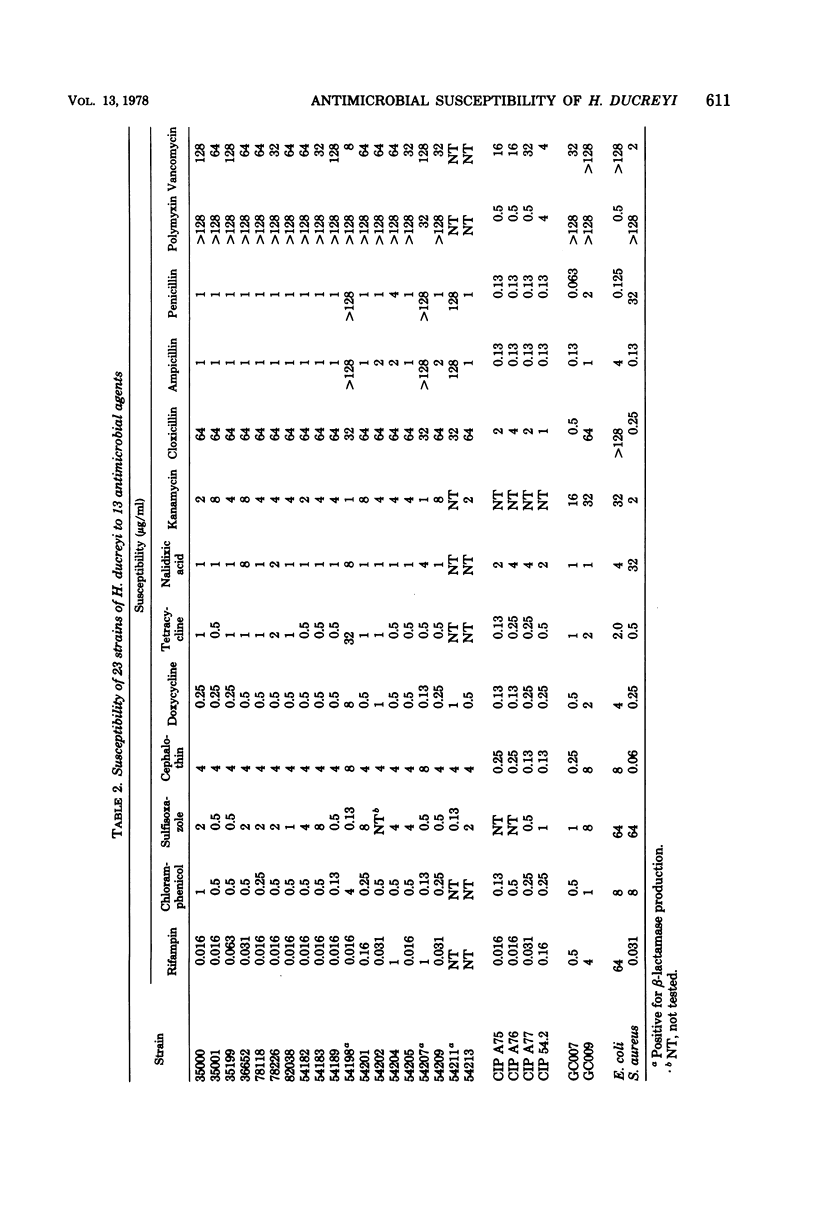Abstract
The susceptibility of 19 isolates of Haemophilus ducreyi from a recent chancroid outbreak and four reference strains was determined in vitro to 13 antimicrobial agents. The rabbit intradermal test for virulence was positive for all of the local isolates, but not for the reference strains. The “nonvirulent” reference strains were inhibited by lower minimum inhibitory concentrations (MICs) of most agents tested. For the virulent isolates, the range of MICs (in micrograms per milliliter) of the following were: of vancomycin, 8 to 128; of polymyxin, 32 to 128; of cloxacillin, 32 to 64; of tetracycline, 0.5 to 32; of cephalothin, 4 to 8; of doxycycline, 0.25 to 8; and of kanamycin, 1 to 8. Three strains were resistant to penicillin and ampicillin (MIC ≥ 128 μg/ml), and these three strains produced β-lactamase. The remainder were susceptible to 4 μg/ml. All strains were susceptible to rifampin (MIC ≤ 1 μg/ml), chloramphenicol (MIC ≤ 4 μg/ml), sulfisoxazole (MIC ≤ 8 μg/ml), and nalidixic acid (MIC ≤ 8 μg/ml). These susceptibilities of H. ducreyi indicate several antimicrobial agents that may be effective for chancroid treatment and support the use of vancomycin in a selective medium for the culture of chancroid genital ulcers.
Full text
PDF




Images in this article
Selected References
These references are in PubMed. This may not be the complete list of references from this article.
- DEACON W. E., SINGER S. Effects of penicillin G in vitro on Hemophilus ducreyi. Public Health Rep. 1956 Nov;71(11):1112–1114. [PMC free article] [PubMed] [Google Scholar]
- Ericsson H. M., Sherris J. C. Antibiotic sensitivity testing. Report of an international collaborative study. Acta Pathol Microbiol Scand B Microbiol Immunol. 1971;217(Suppl):1+–1+. [PubMed] [Google Scholar]
- Hammond G. W., Lian C. J., Wilt J. C., Ronald A. R. Comparison of specimen collection and laboratory techniques for isolation of Haemophilus ducreyi. J Clin Microbiol. 1978 Jan;7(1):39–43. doi: 10.1128/jcm.7.1.39-43.1978. [DOI] [PMC free article] [PubMed] [Google Scholar]
- Hart G. Venereal disease in a war environment: incidence and management. Med J Aust. 1975 Jun 28;1(26):808–810. doi: 10.5694/j.1326-5377.1975.tb82052.x. [DOI] [PubMed] [Google Scholar]
- KAPLAN W., DEACON W. E., OLANSKY S., ALBRITTON D. C. V.D.R.L. chancroid studies. III. Use of Ducrey skin test vaccines on rabbits. J Invest Dermatol. 1956 May;26(5):415–419. doi: 10.1038/jid.1956.53. [DOI] [PubMed] [Google Scholar]
- Kerber R. E., Rowe C. E., Gilbert K. R. Treatment of chancroid. A comparison of tetracycline and sulfisoxazole. Arch Dermatol. 1969 Nov;100(5):604–607. [PubMed] [Google Scholar]
- Kilian M. A taxonomic study of the genus Haemophilus, with the proposal of a new species. J Gen Microbiol. 1976 Mar;93(1):9–62. doi: 10.1099/00221287-93-1-9. [DOI] [PubMed] [Google Scholar]
- Marmar J. L. The management of resistant chancroid in Vietnam. J Urol. 1972 May;107(5):807–808. doi: 10.1016/s0022-5347(17)61144-3. [DOI] [PubMed] [Google Scholar]
- O'Callaghan C. H., Morris A., Kirby S. M., Shingler A. H. Novel method for detection of beta-lactamases by using a chromogenic cephalosporin substrate. Antimicrob Agents Chemother. 1972 Apr;1(4):283–288. doi: 10.1128/aac.1.4.283. [DOI] [PMC free article] [PubMed] [Google Scholar]



